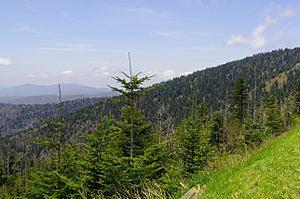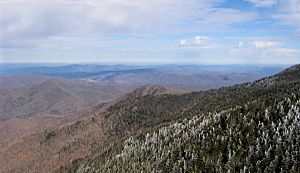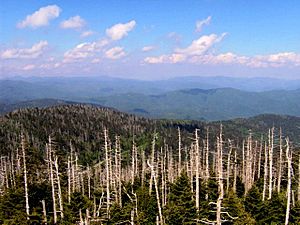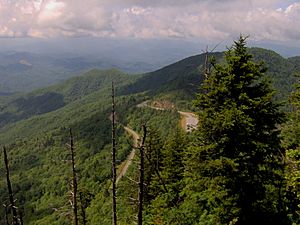Southern Appalachian spruce–fir forest facts for kids

The southern Appalachian spruce–fir forest is a special type of forest found high up in the southern Appalachian Mountains in the eastern United States. It's a cool, unique forest that looks a lot like the forests you'd find in Canada.
This forest grows in the highest and coldest parts of the Appalachian Mountains, usually above 5,500 feet (about 1,676 meters). At these heights, the weather is too harsh for the leafy trees that grow in lower areas. This forest is a leftover from the last Ice Age, which means it's been around for a very long time! It covers only about 100 square miles (about 259 square kilometers) and is considered one of the most endangered ecosystems in the United States.
The southern spruce–fir forest is mostly made up of two types of evergreen trees with needle-like leaves: the red spruce and the Fraser fir. People sometimes call them the "he-balsam" and "she-balsam." Even though these forests look like the "boreal" forests of Canada, they are a unique ecosystem with their own special plants and animals.
Over the last 200 years, these forests have faced many challenges. They have been damaged by logging, pollution, and tiny invasive insects. This forest is home to the Spruce-fir moss spider, which is an endangered species, and several other threatened species. The Fraser fir, which is related to the balsam fir, only grows in these southern Appalachian forests. Sadly, in the late 1900s, most of the older Fraser firs were killed by a tiny bug called the balsam woolly adelgid, which came from Europe around 1900.
Contents
Where Can You Find These Forests?
The southern Appalachian spruce–fir forest is spread out in several areas. Together, these areas cover about 60,000 to 70,000 acres (about 24,281 to 28,328 hectares). The biggest part of this forest is on top of the Great Smoky Mountains, right on the border between Tennessee and North Carolina. It stretches from Clingmans Dome in the west to Mount Guyot in the east.
Another large section is found on the Black Mountains, including a big area on Mount Mitchell. Other important parts of the forest are in the Great Balsam Mountains and the Plott Balsams in southern North Carolina. The Great Craggy Mountains and Mount Pisgah have red spruce trees, but they don't have Fraser firs.
Further north, you can find these forests on the higher parts of Roan Mountain, especially between Roan High Knob and Roan High Bluff. A smaller area is on nearby Grandfather Mountain. The northernmost part of this forest is on Mount Rogers and nearby peaks in Southwest Virginia. Some smaller groups of spruce trees are in West Virginia, but they don't have Fraser firs and are usually considered separate.
Who Owns These Forests?
Most of these special forests, about 95%, are owned by the government, either federal or state. Only about 5% are privately owned. About 85% of the southern spruce–fir forests are in National Park Service areas, like the Great Smoky Mountains National Park and along the Blue Ridge Parkway. They are also found in state parks, such as Mount Mitchell State Park and Grayson Highlands State Park. The remaining 10% of public lands are managed by the United States Forest Service, including the Pisgah National Forest in North Carolina, the Cherokee National Forest in Tennessee, and the Jefferson National Forest in Virginia.
What's the Forest Like?
Weather in the Spruce–Fir Forest
The southern Appalachian spruce–fir forests are much colder than the valleys around them. In winter, temperatures can drop to -30°F (about -34°C), and with wind, it can feel even colder! Strong thunderstorms and heavy rain are common in summer. These forests are often covered in clouds about 25% of the time.
Because they are on mountain tops or ridges, these forests often experience very strong winds, sometimes as fast as 175 miles (about 282 kilometers) per hour. The forest floor is often covered with fallen trees and branches due to these strong winds. Roads and trails in these areas need constant cleaning to remove downed trees.
Plants of the Spruce–Fir Forest
Red spruce and Fraser fir trees can survive at the highest elevations because they can handle extreme weather that most other trees cannot. Both trees have a cone shape and flexible branches. This helps them not break under heavy snow. Their needles also have a special fatty substance that protects them from extreme cold.
Red spruce trees can grow as low as 3,500 feet (about 1,067 meters) and become the main tree type at 5,500 feet (about 1,676 meters). Fraser firs appear at 5,500 feet and become the main tree type at 6,200 feet (about 1,890 meters). You can tell them apart by their needles and cones. Fraser firs have blunt needles and cones that point up, while red spruces have prickly, four-sided needles and cones that hang down. The oldest red spruces are over 300 years old and can grow taller than 100 feet (about 30 meters). When spruce and fir needles fall, they take a long time to break down, creating a special acidic soil layer.
Some other trees, like yellow birch, American mountain ash, and pin cherry, can also be found here. The pin cherry is common in areas that have been damaged by fire. The forest floor is home to shrubs like Catawba rhododendron, thornless blackberry, mountain cranberry, and witch-hobble. Many ferns, such as the mountain wood fern and northern lady fern, grow here, along with over 280 types of mosses. Wildflowers include Canada mayflower, blue-bead lily, and mountain wood-sorrel. The Rugels ragwort is a plant found only in the Great Smoky Mountains' spruce–fir forest. It is one of eight plant species that only grow in this unique ecosystem.
Animals of the Spruce–Fir Forest
The southern Appalachian spruce–fir forests are home to the Spruce-fir moss spider, which is an endangered species. This tiny spider, related to the tarantula, lives among the many types of mosses in the forest. Another endangered animal, the northern flying squirrel, also lives here. The pigmy salamander prefers these forests and is one of several salamander species found only in southern Appalachia.
Bird species you might see include winter wrens, black-capped chickadees, Blackburnian warblers, brown creepers, golden-crowned kinglets, and northern saw-whet owls. Many of these birds are more common in northern areas.
How is This Forest Different from Northern Forests?
While southern spruce–fir forests look like the boreal forests of Canada and Alaska, the main trees, red spruce and Fraser fir, are not found in boreal forests. The Fraser fir, in fact, only grows in southern Appalachia. The climate here is warmer and wetter than in Canada and Alaska, which allows trees to grow taller and faster. The plants growing on the forest floor are also much thicker here. You can find plants like the Catawba rhododendron, which doesn't grow in northern forests.
History of the Spruce–Fir Forest

How the Forest Changed Over Time
Even though the huge ice sheets of the last Ice Age didn't reach the southern Appalachians, the weather changes they caused made the region much colder. About 18,000 years ago, when the Ice Age was at its coldest, spruce–fir forests covered much of the southeastern United States. They stretched west to Missouri and south to Louisiana. The leafy deciduous forests were only found in a few small areas near the coast.
At the highest points in the southern Appalachians, above 4,950 feet (about 1,509 meters), there was an alpine zone. This was a place where it was too cold for any trees to grow, only tundra plants and frozen ground. Between 16,000 and 12,000 years ago, temperatures started to get warmer. The deciduous forests returned to the mountain valleys. By about 10,000 years ago, the alpine zones were gone, and the spruce–fir forest had moved back to only the highest mountain tops.
People and the Forest
Scientists like John Bartram and André Michaux started exploring the diverse southern Appalachian forests in the late 1700s. On one trip, Michaux was with a Scottish scientist named John Fraser, who discovered the fir tree that is now named after him. Early settlers called the Fraser fir the "she-balsam" because of the white spots on its branches that looked like milk. The dark color of the spruce–fir trees, compared to the bright green of the leafy forests, is why many mountains in the southern Appalachians are named "Black," like the Black Mountains. The nicknames for the red spruce and Fraser fir (he-balsam and she-balsam) also led to names like Richland Balsam.
For most of the 1800s, these high-up forests were mostly left alone because they were hard to reach. However, places like Mount Mitchell and Roan Mountain became popular vacation spots for people wanting to escape the hot summer heat. While some trees were cut down as early as the 1880s, the early 1900s saw a big increase in logging in these forests, especially during World War I. Red spruce wood was very popular for building airplanes.
Most of the spruce–fir areas in the Great Smoky Mountains were saved from this logging. But almost half of the untouched spruce forests in other parts of the southern Blue Ridge Mountains were either cut down or destroyed by fires caused by logging. This fast destruction led to many efforts to protect the forests. One effort, led by North Carolina governor Locke Craig, resulted in the creation of Mount Mitchell State Park in 1915. The creation of national forests around the same time helped control commercial logging and allowed much of the forest to start recovering.
Threats to the Forest

The balsam woolly adelgid is the biggest threat to the southern spruce–fir forest. This tiny insect came from Europe in the early 1900s and quickly destroyed the balsam fir trees in the northern Appalachians. In 1957, it was found on Mount Mitchell, and by 1963, it had spread to Mount Sterling in the Great Smoky Mountains. Over the next few decades, this bug killed almost all the older Fraser firs in southern Appalachia. While new Fraser firs grow, most are attacked and killed after just a few years. Attempts to get rid of the balsam woolly adelgid by bringing in insects that eat it have not worked well. It's also hard to help Fraser firs grow back because their cones are very popular with tree growers, especially Christmas tree growers. The United States Forest Service is often asked to allow people to collect these cones.
The loss of the older Fraser firs has greatly impacted the southern spruce–fir ecosystem. The spruce–fir moss spider, which liked the cool shade under the firs, is now thought to be gone from most places except a few in North Carolina. The red spruce trees also relied on the stronger Fraser firs for protection from strong winds in the high, windy areas. Air pollution and acid rain are also believed to be slowing the growth of red spruces, especially since these forests are often in clouds. How much they are affected is still being studied.
A recent study in the Great Smoky Mountains showed that the number of adult fir trees has actually increased over 30 years. For example, Clingmans Dome had three times as many adult trees in 2020 as it did in the 1980s. This gives some hope for the future of the Fraser fir.
How to Visit These Forests

Even though these forests are in remote areas, most of them can be reached by federal and state roads. The Blue Ridge Parkway goes through the spruce–fir regions in the Plott Balsams, the Great Balsams, the Black Mountains (where North Carolina State Highway 128 connects to Mount Mitchell), Grandfather Mountain, and Mount Rogers. In the Great Smoky Mountains National Park, U.S. Route 441 goes up to Newfound Gap through the spruce–fir forest. From there, you can take the 7-mile (about 11-kilometer) Clingmans Dome Road. The Roan Mountain spruce–fir area can be reached by state highway (Highway 143 in Tennessee and Highway 261 in North Carolina). A paved road also goes to the gap between Roan High Knob and Roan High Bluff, where there is a large rhododendron garden.
The Appalachian Trail also passes through the southern spruce–fir forests in the Great Smokies and on Roan Mountain and Mount Rogers. Other important trails in these areas include the Deep Gap Trail in the Black Mountains and the Balsam Mountain Trail and Boulevard Trail in the Great Smokies. Smaller trails, part of the Blue Ridge Parkway, lead to the tops of Waterrock Knob in the Plott Balsams and Richland Balsam in the Great Balsam Mountains.




